
American researchers from the University of California, San Diego have developed a system that synthesizes cell membranes with metabolic activity.
Scientists have long been concerned with the question of how inanimate organic compounds gave rise to the first forms of life at some point. This transition from inanimate matter to living organisms remains one of the unresolved issues.
Researchers are currently creating synthetic cells that behave like real biological cells. Scientists identify three key features inherent in living organisms:
- Compartmentalization — a kind of boundary between the internal environment of the cell and the outside world
- Metabolism — chemical processes that synthesize some molecules and destroy others to maintain cellular activity
- Selection, in which some molecules have a natural advantage over others because of their properties or efficiency
Most studies have focused on compartmentalization. However, metabolism is no less important. It is metabolism allows living organisms to reproduce, adapt and evolve, continuously recycling molecules in response to changes in the environment.
«Cells without a metabolic network are stuck — they are unable to rearrange, grow, or divide. Life today is at a high evolutionary level, but we want to understand whether metabolism can occur in very simple chemical systems before the evolution of more complex ones», — explains the study leader, Murray Goodman Chair in Chemistry and Biochemistry at the University of California, San Diego Neil Devaraj.
Fatty compounds — lipids play an important role in many cellular functions. Lipid membranes serve as barriers in many biological cells Lipid membranes are dynamic and able to be reorganized in response to cell needs.

An important step in understanding the evolution of living cells was the creation of a laboratory Devarajah’s system, in which lipids not only form membranes but can also destroy them through metabolic processes. The created system was abiotic, that is, it used only inanimate matter.
«We are trying to answer the fundamental question: what are the simplest systems that have the properties of life?», — says the first author of the study, Researcher at the Devaraj Laboratory Alessandro Fracassi.
The cycle created by the researchers uses chemical fuel to activate fatty acids. The fatty acids are then combined with lysophospholipids to form phospholipids. Phospholipids spontaneously form membranes, but in the absence of fuel they disintegrate and turn into fatty acids and lysophospholipids, and the cycle begins anew.
Once the researchers have demonstrated the feasibility of creating a synthetic cell membrane, they plan to increase the complexity until they create something with significantly more properties associated with life.
«In addition to shedding light on how life might have originated in an abiotic environment, the development of artificial cells could have an impact on the world around us. Drug delivery, biomanufacturing, environmental remediation, biomimetic sensors — all of these will become possible in the coming decades as we continue to deepen our understanding of how life on Earth came to be. We may not see similar achievements for another 10 or 20 years But we need to work today because we still have a lot to learn», — emphasizes Alessandro Fracassi.
The results of the study are published in the journal Nature Chemistry
Source: SciTechDaily

Spelling error report
The following text will be sent to our editors: